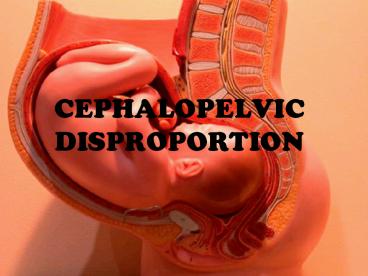CEPHALOPELVIC DISPROPORTION - PowerPoint PPT Presentation
1 / 29
Title:
CEPHALOPELVIC DISPROPORTION
Description:
CEPHALOPELVIC DISPROPORTION Implies disproportion between the head of the baby (cephalus) and the mother s pelvis Complications can occur if the fetal head is too ... – PowerPoint PPT presentation
Number of Views:5252
Avg rating:3.0/5.0
Title: CEPHALOPELVIC DISPROPORTION
1
CEPHALOPELVIC DISPROPORTION
2
- Implies disproportion between the head of the
baby (cephalus) and the mothers pelvis - Complications can occur if the fetal head is too
large to pass through the mothers pelvis or
birth canal - One of the commonest cause of different
complications in labor - Very frequently diagnosed and is a very common
indication of cesarian sections
3
CAUSES
- increased fetal weight
- fetal position
- problems with the pelvis
- problems with the genital tract
4
SIGNS AND SYMPTOMS
- the delivery of the baby is obstructed
- The labor is prolonged
5
pathophysiology
6
Disproportion between head of the baby and the
mothers pelvis
Fetus does not engage but remains floating
malposition
Premature rupture of membranes
Trial labor
Prolonged labor
Uterine cord prolapse
Delayed second stage
Fetal distress!!
7
DIAGNOSIS
- Estimation of the size of the pelvis
- Clinical pelvimetry assessment of the size of
the pelvis is made manually by examining the
pelvis and palpating the pelvic bones by vaginal
examination - Radiologic pelvimetry xrays or CT scans are
taken of the pelvis in different angles and views
and the pelvic diameter measured.
8
DIAGNOSIS
- Ultrasound estimation of the babys size can be
made by ultrasonogram
9
MANAGEMENT
- Cesarian section
10
NURSING DIAGNOSIS
- Anxiety
- Fatigue
- Risk for fetal injury
- Risk for impaired skin integrity
- Situational low self- esteem
11
interventions
- Monitor heart sounds and uterine contractions
continuously, if possible, during trial labor. - Urge the woman to void every 2 hours s
- Assess FHR carefully
- Establish a therapeutic relationship, conveying
empathy and unconditional positive regard - Instruct in methods to conserve energy
- Massage bony prominences gently and change
position on bed in a regular schedule - Convey confidence in clients ability to cope
with current situation
12
PREGNANCY INDUCED HYPERTENSION
13
Pregnancy- induced hypertension
- A condition in which vasospasm occurs during
pregnancy in both small and large arteries - Originally was called toxemia
- Cause unknown
14
Risk Factors
- Women of color, or with a multiple p regnancy,
primiparas lt20 years of age or gt40 years - Women from low socioeconomic backgrounds, whose
who have had 5 or more pregnancies, those who
have hydramnios, or those who have underlying
disease (e.g. heart disease, DM with vessel or
renal involvement, essential HPN)
15
Signs and symptoms
- HPN
- Proteinuria
- Extensive edema
- Vision changes
16
Classifications of PIH
- Gestational HPN
- ? BP but has no proteinuria or edema
- no drug therapies necessary
- Mild Preeclampsia
- BP rises to 140/90 mmHhg, taken on 2 ocassions
at least 6H apart - systolic BP gt30 mmHg and diastolic pressure gt15
mmHg above pre pregnancy values - proteinuria (1 or 2 on a reagent test strip on
a random sample) - edema
17
- Severe preeclampsia
- BP of 160 mmHg (systolic) and 110 mmHg
(diastolic) - proteinuria (3 or 4 on a random urine sample
or more than 5 g on a 24H sample) - extensive edema
- Eclampsia
- seizure or coma accompanied by s/sx of
preeclampsia
18
pathophysiology
19
Increased cardiac output
Injury of endothelial cells of the arteries
leading to vasospasm
Change in the action of prostaglandins resulting
to Vasoconstriction
Dec blood supply and O2 perfusion To vital organs
hypertension
Liver/ pancreas
Kidneys
placenta
20
kidneys
Dec glomerular filtration
Glomerular degeneration
Inc tubular reabsorption of sodium
Inc glomerular permeabilty
water retention
Escape of serum proteins, albumin And globulin,
into the urine (proteinuria)
edema
oliguria
Fluid diffuses from circ system to extracellular
spaces
Gen H2O retention
21
LIVER
Tissue ischemia
Vascular stasis
Epigastric pain
Convulsion!!
22
PLACENTA
Tissue ischemia
Release thromboplastin-like substances
Premature placental deterioration
Dec fetal nutrient
Abruptio placenta
Fetal distress
Premature labor and delivery
23
Nursing diagnoses
- Decreased cardiac output
- Ineffective tissue perfusion
- Fluid volume excess
- Urinary retention
- Risk for fetal injury
- Social isolation
24
Nursing interventions
- Mild PIH
- Promote bed rest lateral recumbent position
- Promote good nutrition usual pregnancy diet
- Provide emotional support instruct woman to
report if symptoms worsen, bring concerns out
into the open
25
- Severe PIH
- Support bed rest visitors restricted to support
people, darken room, if possible, provide clear
explanations of what is happening and what is
planned, allow opportunity to express feelings - Monitor maternal well-being monitor BP q4H,
obtain blood studies, daily hematocrit levels as
ordered, anticipate need for freq plasma estriol
levels and electrolyte levels, obtain daily wts
and MIO
26
- Monitor fetal well being single doppler
auscultation approx 4H interval, FHR maybe
assessed with an external fetal monitor, NST or
BPP daily, O2 admin to mother - Support a nutritious diet moderate to high in
protein and moderate in sodium, IVF line
27
- Administration medications to prevent eclampsia
- hydralazine/ Apresoline
- labetalol/ Normodyme
- DOC magnesium sulfate antidote calcium
gluconate - Eclampsia
- - seizure precautions
28
(No Transcript)
29
Prepared by
miko
camay
ricah

